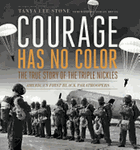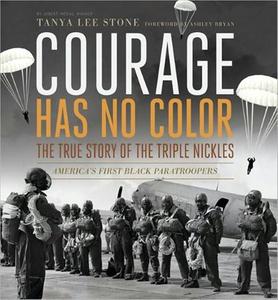
 Tanya Lee Stone, whose history of women in the space program, Almost Astronauts, won the 2010 Sibert Medal, here offers another penetrating and illuminating look at a courageous, boundary-breaking group with plenty of guts and little glory: the Triple Nickles.
Tanya Lee Stone, whose history of women in the space program, Almost Astronauts, won the 2010 Sibert Medal, here offers another penetrating and illuminating look at a courageous, boundary-breaking group with plenty of guts and little glory: the Triple Nickles.
She begins her history by asking readers to imagine what it was like to jump out of an airplane as a paratrooper. Into her step-by-step description she weaves both suspense and also entertaining terms (the jumpmaster commands, "Load," to signal it's time to climb into the plane; the line of troopers is called a "stick"). Twenty African-Americans trained for combat during World War II to become members of the first all-black paratrooper unit, called the Triple Nickles. Their journey takes many surprising twists and turns--an odyssey of spiritual, physical and mental strengthening unlike that of their white counterparts. As Stone puts it: "What is courage?... Perhaps it is being ready to fight for your nation even when your nation isn't ready to fight for you."
Many individual stories come to the fore in the shaping of this larger history. The main thread of the narrative belongs to Walter Morris, first sergeant of the Service Company of the Parachute School at Fort Benning, Ga. In an attempt to keep up the morale of his men, whose job was to safeguard the facility, Morris began putting them through the exercises he'd watched the white jumpers practice. At the same time, A. Philip Randolph was planning a march on Washington, D.C., in 1941; President Franklin Delano Roosevelt averted the protest by signing the Fair Employment Act, a nod to integrating the armed forces without actually requiring it. Gen. Ridgely Gaither, who had observed Morris and his men, drafted them into the first all-black unit of paratroopers: the 555th Parachute Infantry Company. But it would take Harry S. Truman to integrate the military fully.
Stone shows how the 555th Parachute Infantry Company made an impact in other unexpected ways, connecting back to the war in the Pacific. She shares a little-known story of balloon bombs sent by Japan and kept secret by U.S. intelligence. The photos that Stone's research uncovered documents the professionalism of these men and the sacrifices they made, even as their white peers issued taunts and physical threats. The author's endnotes about her research and decisions based on the facts she could confirm make this an invaluable book for young people just starting to embark on research projects of their own. A fascinating, thorough and inspiring account. --Jennifer M. Brown
Shelf Talker: An award-winning researcher and writer tells the story of 20 brave African-American men who break all kinds of ground, including the color barrier in World War II.

